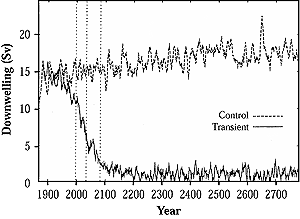|
16.2.2. Changes around the Antarctic Peninsula
At least five meteorological records from scientific stations on the Antarctic
Peninsula show marked decadal warming trends (King, 1994; Harangozo et al.,
1997; King and Harangozo, 1998; Marshall and King, 1998; Skvarca et al., 1998).
Although the periods and seasons of observations have been different, the records
show consistent warming trends—as much as 0.07°C yr-1, considerably
higher than the global mean. This atmospheric warming has caused several notable
changes in the ice cover of the Antarctic Peninsula, including changes in snow
elevation (Morris and Mulvaney, 1995; Smith et al., 1999a) and the extent of
surface snow cover (Fox and Cooper, 1998). The most important change has been
the retreat of ice shelves. Seven ice shelves on the Antarctic Peninsula have
shown significant, progressive, and continued retreat. On the West Coast, the
Wordie Ice Shelf, Müller Ice Shelf, George VI Ice Shelf, and Wilkins Ice
Shelf have retreated (Ward, 1995; Vaughan and Doake, 1996; Luchitta and Rosanova,
1998). On the east coast, the ice shelves that occupied Prince Gustav Channel
and Larsen Inlet and Larsen Ice Shelf A have retreated (Rott et al., 1996; Vaughan
and Doake, 1996; Skvarca et al., 1998). Following Mercer (1978), Vaughan and
Doake (1996) show that the pattern of retreat could be explained by a southerly
movement of the 0°C January isotherm, which appears to define a limit of
viability for ice shelves. To date, about 10,000 km2 of ice shelf
have been lost.
|

Figure 16-5: Volume transport of Antarctic downwelling
past 1,250-m depth level for control and transient climate integrations.
Values are in Sverdrups (Sv), filtered using a 7-year running mean,
and are for the area of the Southern Ocean between Antarctic coast and
45°S (from Hirst, 1999, Figure 11).
|
Retreat of the ice shelves on the Antarctic Peninsula
has attracted considerable media coverage, and environmental campaigns of some
nongovernmental organizations (NGOs) have expressed concern that these events
presage a more important collapse of the West Antarctic ice sheet. However,
few direct impacts result from the loss of these ice shelves. The ice shelves
were floating, so their melting does not directly add to sea level, and they
usually are replaced by sea-ice cover, so overall albedo changes very little.
Because the Antarctic Peninsula is steep and rugged, there is no evidence that
removal of ice shelves will cause melting of the glaciers that fed them to accelerate
and add to sea-level rise (Vaughan, 1993). Terrestrial ecosystems generally
will be unaffected by ice-shelf retreat. Most polar benthic organisms, especially
in the Antarctic, grow extremely slowly, so colonization of exposed seabed will
be slow.
Because warming on the Antarctic Peninsula exceeds that over much of the rest
of the continent (Jacka and Budd, 1998), migration of the limit of viability
for ice shelves probably will not affect the Ronne-Filchner or Ross ice shelves
in the next 100 years (Vaughan and Doake, 1996). A substantial increase in Antarctic
summer temperatures, however, would threaten other large ice shelves beyond
the Antarctic Peninsula. The real implications of ice-shelf retreat are that
it highlights issues of risk perception and public understanding of climate
change, rather than real physical impacts. These issues include questions such
as: Does the Antarctic Peninsula warming result from a global effect, or simply
from natural regional climate variations? Such problems of attribution of climate
change will recur, especially if the costs of adaptation are to be spread across
nations. The inherent nonlinearity of natural systems sometimes causes exaggerated
local responses to small climate changes. In the present generation of climate
models, the Antarctic Peninsula is not well resolved, so local effects on these
scales cannot yet be reproduced. Confidence in predicting such changes in the
natural ecosystems of the Antarctic Peninsula comes from observed changes on
the terrestrial biota of southern ocean islands (Bergstrom and Chown, 1999).
Rapidly increasing temperatures have been directly implicated in colonization
by introduced species and displacement of indigenous biota. Thus, the extent
of higher terrestrial vegetation on the Antarctic Peninsula currently is increasing
(Fowber and Lewis Smith, 1994). In the marine environment, the warming trend
on the Antarctic Peninsula has been linked statistically to an associated change
in sea ice for this region (Stammerjohn and Smith, 1996). For example, Smith
et al. (1999b) show that rapid climate warming and associated reduction in sea
ice are concurrent with a shift in the population size and distribution of penguin
species in the Antarctic Peninsula region.
|